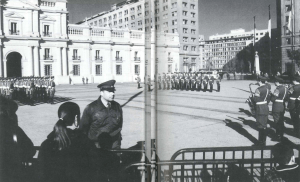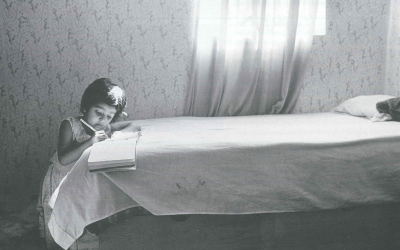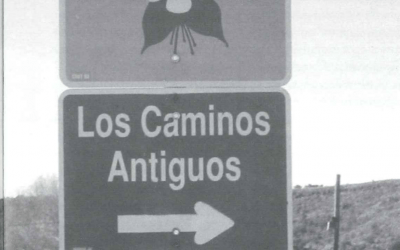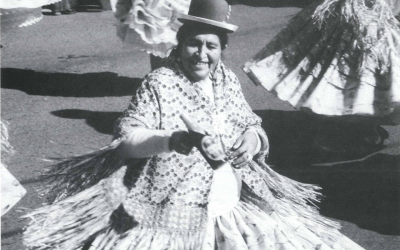Human Rights Tourism in Chile

In front of La Moneda. Photo by Ann Stanton.
Most tourists to Chile are tempted by opportunities to see blue glaciers in Chile’s Tierra del Fuego or sample wines in Chile’s trendy vineyards. I also wanted to visit the National Stadium.
While working as an intern this summer at the U.S. Embassy in Santiago, I expressed to my Chilean host an interest in the stadium—the site of the majority of torture and executions after a military coup toppled Chile’s elected president and established Augusto Pinochet as a dictator in 1973. Bewildered at my interest, my friend asked, “Why? It’s just a plain soccer stadium.”
I explained that I wanted to visit the stadium for its historical importance, since so many people had been killed there. She replied, “You must be confused. I don’t think anyone was killed there. People were detained there since the prisons were full, but no one was killed.” A co-worker acknowledged, “Well, I think some people were killed there, but not very many. More people died on the Titanic.” In fact, 1,300 people died on the Titanic. More than 3,000 people were killed during Pinochet’s rule, and about 400,000 were tortured. Though not all the murder and torture took place in the national stadium, the stadium was the nation’s largest detention center; Red Cross International estimates that about 7,000 prisoners were detained there. Several weeks later as I returned home late one evening, my host looked up from her favorite Chilean soap opera and exclaimed to me, “You’re right! I saw a special on TV today. People were killed in the stadium.” Twenty-eight years after the fact she has just realized the extent of the atrocity that she lived through as a young bride.
As an American in Chile, I often found that, like my friend, many Chileans either didn’t know or chose to forget the country’s painful past. I set out to explore its human rights legacy. I discovered that leftist-leaning Chileans fleeing after the 1973 coup opened museums around the world to which artists donated pieces to show their solidarity with Allende and his ideals with the idea of sending the artworks back to Chile when democracy was restored. The Salvador Allende Solidarity Museum in Santiago is now an incredible art museum with Calder sculptures, Miró paintings, and other works of famous and not-so-famous artists who were painting during Pinochet’s regime.
I visited La Moneda, where the coup took place, and the Plaza de Armas, where the first human rights resistance emerged. I took many pictures at former torture site Villa Grimaldi, now the Parque por la Paz. I strolled through the park, reading its plaques with poetic words remembering those killed there, and contemplating a sculpture dedicated to the victims. I soon found that I was not the only tourist in Chile intrigued by its human rights legacy. I learned about the Human Rights Legacy tour in my Lonely Planet: Santiago guide book.
Steve Anderson, the agency’s founder, told me that the agency aims to “keep alive the memory of what really happened” during General Augusto Pinochet’s seventeen-year military dictatorship.
The Chile Information Project (CHIP) tours seek to convince customers that torture and murder really did occur during Pinochet’s regime and to impress upon them the atrocity of the crimes committed. In order to convince visitors that the events really happened, CHIP’s tour takes clients to Villa Grimaldi, to the presidential palace where the strafing from the military coup can still be seen on the building, and to the National Cemetery where Salvador Allende is buried. Though the sites are memorable, the tour offers little information that could not be gathered, even more dramatically and poignantly, from reading a survivor’s testimony of the atrocities or watching the Costa-Gavras movie Missing. Where the tour shines is in its visit to the Pinochet Foundation.
CHIP founder Anderson explains that he takes visitors to the foundation so that they can hear the arguments that Pinochet’s most loyal fans make about Pinochet’s achievements and the merit of his harsh reign and judge the events for themselves. He has no doubt that his clients will find the Pinochet Foundations’s explanations “pathetic and unsatisfying.” Visitors see a plaque that honors those who were killed by leftists, watch a black and white video of the chaos of the Allende regime, then watch a cheerful, color video of Pinochet’s regime and all its accomplishments, and finally a representative of the foundation discusses Pinochet’s accomplishments.
Visitors need to understand this passionate loyalty that some Chileans have to Pinochet. Chile’s view of Pinochet is not black and white. I arrived in Chile assuming that everyone would think as I did that Pinochet was the worst thing that had ever happened to Chile. But time and time again in my conversations with Chileans, my assumptions were refuted. Not all Chileans agree with the typical foreign depiction of Pinochet as a mass murderer. He is not all bad. Quite the contrary. To some Chileans—particularly the upper class—he is responsible for a lot of good. Not all Chileans regret his brutal seventeen-year dictatorship.
For me, CHIP’s tour reconfirmed the sense of the complexity of Chilean political sentiments that I had gleaned from reading the mostly conservative Chilean newspapers and from having extensive political conversations with my host family and other social acquaintances. But for those who do not have a chance to live with a family or interact socially with Chileans, CHIP’s Human Rights Legacy tour may be the only way to discover the extreme diversity of views about Pinochet and to get a sense of how this diversity affects daily life.
In any country whose past is tainted by tragedy, a historical memory tour that reminds visitors of the country’s past is valuable so that the world never forgets the tragedy. In nearby Argentina, tourists follow the Mothers of the Plaza de Mayo, and Buenos Aires is in the process of constructing a Memory Park. In both countries, human rights legacy is still very much in the news. Since a Chilean court of appeals declared Pinochet unfit to stand trial due to dementia, Chileans have tracked his various illnesses including diabetes, strokes, hypertension, circulatory problems, and, most recently, toothaches. Every day, Chilean papers describe the latest developments as Joyce Horman, whose husband, Charles, disappeared in Chile during the first days of Pinochet’s dictatorship, fights to bring Pinochet to trial and, most recently, works to force Henry Kissinger to testify in the criminal case.
For an American student from Harvard University, being an intern during the week and a tourist on the weekends created an unexpected cultural confusion. Informal and formal human rights legacy touring helped me determine what I wanted to think about Chile’s past. Many Chileans I met attribute their wealth and comfort entirely to Pinochet. They remember the violence and unpredictability of the Allende years—never knowing when the power would go out, when the food would run out, when their homes would be looted or their businesses seized. Pinochet put an end to this upheaval. Above all, he restored order. Those who heap the loftiest praise on Pinochet often admit that he killed many people but insist that such killings were necessary. “What was most important was that he restored order. He had to kill those people. What else could he do? They would have disrupted society. You would have done the same,” my Chilean host explained to me.
During my stay in Chile I was invited to the most elegant and extraordinary wedding I have ever attended. The dinner-dance after the wedding was held in a huge tent in the countryside because none of Santiago’s grand ballrooms could accommodate the 600 invitees. Though pleased with the fantastic turnout for the wedding, the bride’s parents seemed put out that Pinochet had neither turned up to celebrate their daughter’s marriage with them nor responded to their invitation with his regrets. Their grumbling amazed me.
To say that views about Pinochet divide families and determine friendships may be a bit of an overstatement, as friendships certainly can transcend the bounds of political ideologies. But disagreement on such a significant, defining subject undoubtedly strains relationships. I had the opportunity to discover this own my own, since working at the embassy and living with a family gave the time and contacts I needed to begin to understand my host society. However, tourists who come to a country for a short visit often need a helping hand to understand the legacy of human rights—thus the need for an organized tour.
CHIP day tours could not, and does not intend to, fully illuminate the complexity of political sentiments in Chile. But the tour is an ideal starting point for anyone desiring insight into Chilean culture, providing a variety of perspectives on Chile’s political history. The tour doesn’t visit the National Stadium, though.
The stadium can only be entered for ticketed events. Anderson later told me there’s a plaque inside honoring those who were tortured and murdered there. I saw it briefly one day when my host, who treated me like a daughter the entire summer, detoured from our route to show me the stadium. At that time, she still didn’t think that he stadium had any historical significance, but since I wanted to see it, she was willing to drive by.
Perhaps some day I will return to the stadium with my Chilean host for a concert or a soccer game, and I will share with her the human rights legacy I learned about as a tourist.
Winter 2002, Volume I, Number 2
Nell Haddock, a junior government concentrator from Arizona, spent the summer in Santiago, Chile, with a DRCLAS internship grant, working as an intern in the consular section of the U.S. embassy, skiing in the Andes, browsing local markets, reading Pablo Neruda’s poetry, and acquiring a rich vocabulary of Chilean slang that has made her Spanish practically unintelligible to non-Chileans. Addicted to foreign travel and Chilean sea bass, Nell hopes to return to Chile soon to travel the austral trail to the Tierra del Fuego.
Related Articles
Editor’s Letter: Tourism
Ellen Schneider’s description of Sandinista leader Daniel Ortega in her provocative article on Nicaraguan democracy sent me scurrying to my oversized scrapbooks of newspaper articles. I wanted to show her that rather than being perceived as a caudillo
Recreating Chican@ Enclaves
Centrally located between southern Colorado and northern New Mexico, is a hundred-mile long by seventy-mile wide intermountain basin known as the San Luis Valley. Surrounded on the east …
Tourist Photography’s Fictional Conquest
Recently, while walking across the Harvard campus, I was stopped by two tourists with a camera. They asked me if I would take a picture of them beside the words “HARVARD LAW SCHOOL,” …




